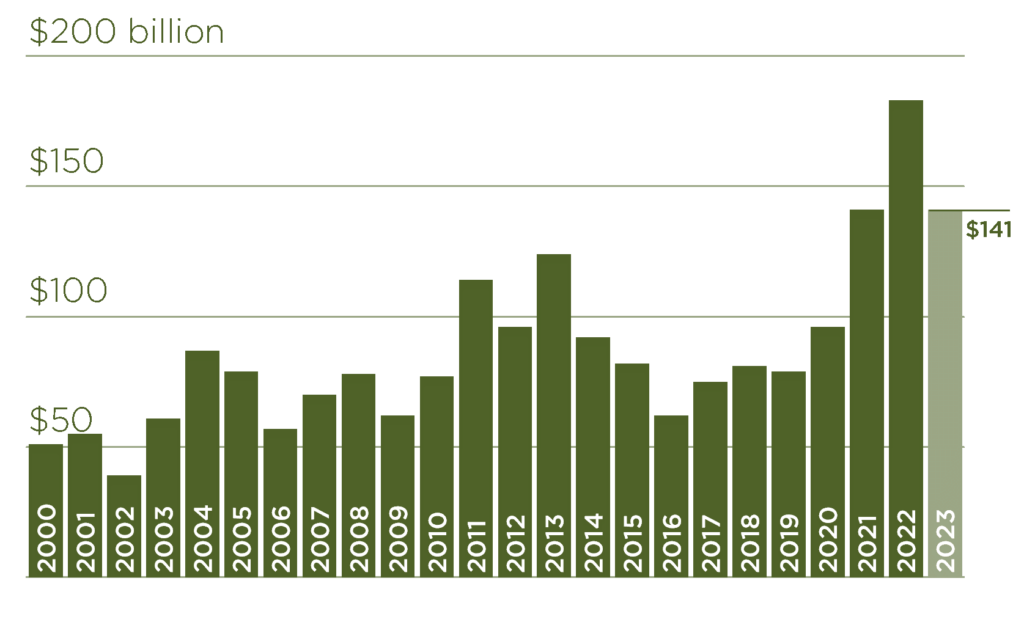U.S. farm net income falls but remains high
The USDA released its most recent Farm Sector Income Forecast in late August. The report indicates that a significant drop in farm net income, a broad measure of farm profitability, is projected for 2023, fully reversing the record increase in farm net income that occurred in 2022. This was also the first report which includes the finalized 2022 farm net income figure — which was roughly $20 billion higher than previously estimated. The difference came mostly from an upward revision to cash receipts and a downward revision to production expenses. Details from the report can be found below.

- Total U.S. farm net income for 2023 is currently estimated to be $141 billion. This would be significantly lower than 2022’s record $183 billion but would match 2021 for the second highest on record.
- Government payments to farms are estimated to have decreased by $3 billion to $13 billion in 2023. After a more elevated total for the last few years due to pandemic-related government support, the estimate for 2023 is in line with the average of the 20 years leading up to the pandemic.
- Aside from cattle and turkeys, all other major categories of livestock (e.g., dairy products, broilers, hogs, chicken eggs) saw lower prices in 2023, resulting in a large decrease in projected cash receipts. This was the most significant contributor to the decrease in projected farm net income.
- The highest revenue crops (i.e., corn and soybeans) are expected to see declining receipts this year due to prices falling from their 2022 peaks. Receipts are still expected to be very high from a historical perspective, but down from last year’s record totals.
- Expenses from some major inputs like fertilizer, fuels, and oil are expected to recede due to falling input costs, but total production expenses are projected to rise for a sixth straight year. Growth in expenses is coming from, among others, marketing, transportation, and higher feed costs.
- S. farm sector debt is projected to increase to a record $540 billion in 2023. This is split between $354 billion in real estate debt and $165.7 billion on non-real estate debt, which are both records. This will be important to monitor going forward in an elevated interest rate environment.
Ag News Highlights
Survey indicates ag economy remains resilient
The Ag Economists’ Monthly Monitor, a recently started survey of agricultural economists jointly administered by the University of Missouri and Farm Journal, suggests that many experts are impressed by the strength of the U.S. agricultural economy. Only five percent expect the ag economy to be worse a year from now compared to current conditions. Survey respondents also expect net farm income less federal support to be in the range of $125-$130 billion, which is a significant step down from 2022 but still a strong figure — especially when considering weakening demand for U.S. ag commodities (see page two for more on net farm income).
There was also widespread belief that consolidation may be coming to the beef cattle industry. According to an anonymous respondent, “I do think consolidation of all parts of the beef industry is coming. I think this will be a time when some of our well-established 100-cow operations will think about exiting.” As for the current cattle market, ag economists believe cattle prices could continue to rise due to further herd contraction. According to Professor Scott Brown of the University of Missouri, “It will probably be late 2025 or 2026 before we see significant increases in beef production. So, if demand at all stays with us, we can be talking about these kinds of lofty prices for several months down the road.” (AgWeb)
A new ag caucus forms in House
A bipartisan group from the U.S. House of Representatives has formed the Agriculture Trade Caucus, a new caucus with the goal of increasing U.S. market access in agricultural trade. “We want to make sure we have the markets opening around the world,” said Adrian Smith, a Republican Congressman from Nebraska. “Anything we do on trade in terms of new discussions and new conversation, needs to ultimately be an enforceable trade agreement that is robust.”
Amid a trade dispute with Mexico regarding Mexico’s possible violation of the USMCA, the USDA is projecting the largest ag trade deficit in more than 20 years for FY 2024. The strong US dollar has been a key factor, promoting new competition for core and soybean exports across the globe.
Citations/Disclaimers
-
The information in this report is provided by Nationwide Economics and is general in nature and not intended as investment or economic advice, or a recommendation to buy or sell any security or adopt any investment strategy. Additionally, it does not take into account any specific investment objectives, tax and financial condition or particular needs of any specific person.
The economic and market forecasts reflect our opinion as of the date of this report and are subject to change without notice. These forecasts show a broad range of possible outcomes. Because they are subject to high levels of uncertainty, they will not reflect actual performance. We obtained certain information from sources deemed reliable, but we do not guarantee its accuracy, completeness or fairness.

